Site menu:

December 2019 Newsletter
Species Spotlight - Siskin.
Colour Ring Report.
November Bird News.
Forthcoming Events.
Latest Newsletter.
Species Spotlight - Siskin
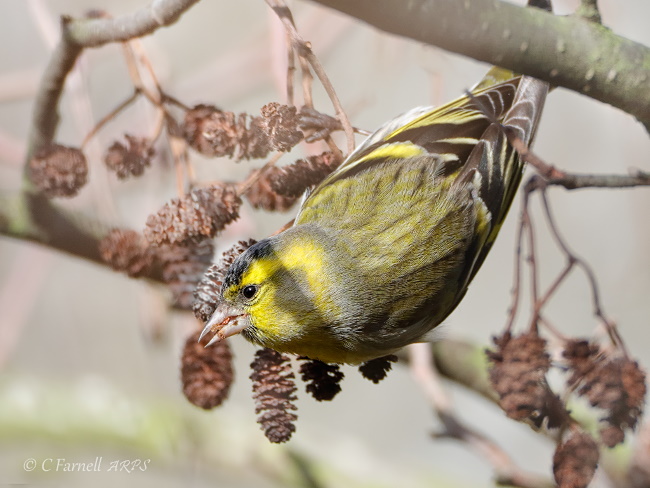
The Siskin (Spinus spinus)
is a scarce bird along the North Wirral and Dee estuary coasts
except during spring and autumn migration. A few do breed inland in
Cheshire and North Wales, in such places as Delamere and Macclesfield
Forests, and the Clwyd Range, and in winter flocks can be seen in the
same forests and
elsewhere sometimes up to 100 strong, but they are largely absent on
the coast at this time. In Spring, however, they can be widespread both
migrating north in flocks along the coast and coming to garden feeders
especially in years when there is a shortage of tree seeds. Autumn is
also a good time to see flocks flying through although most years it is
usually a case of just a handful of small flocks, but this autumn the
passage was exceptional.
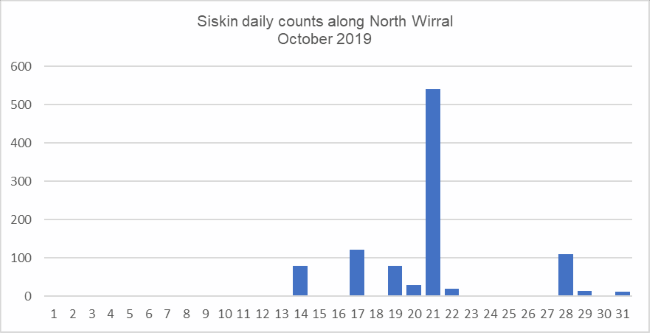
The graph above shows the daily counts through
October with three three-figure counts including 540 on the 21st
beating the previous highest daily count for North Wirral when 524 were
counted at Red Rocks on October 15th 2007. The total for October was
1009, easily beating the previous highest count 0f 667 also in 2007. So
was this part of a national influx from the continent? Looking at data
provided by the Migration Monitoring website (Trektellen.org,
see the two graphs below showing UK data for 2019 and 2017) it seems
the autumn 2019 Siskin migration in the UK was unusual as there was a
distinct spike in records in the second week of October (the 2017 graph
shows a more normal distribution), and we know 1,200 were counted
coming in off the North Sea at Spurn on the 12th, a high count even for
there. So the birds seen here ten days later could well be part of that
movement.
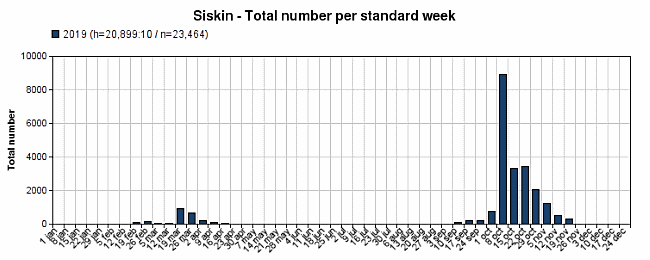
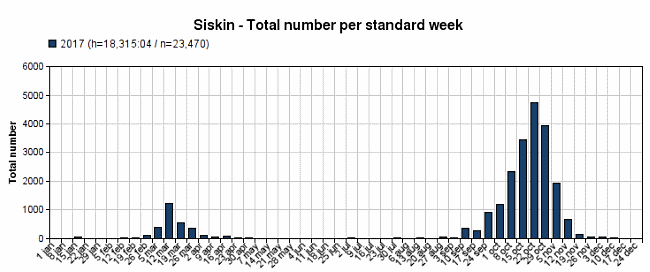
One thing that was unusual was that the Siskins
along the north Wirral coast during October were flying the 'wrong
way', south-west to north-east instead of the more normal reverse
direction - in other words heading back towards Spurn! Given that the
wind direction was from the north-east we shouldn't be too surprised as
birds will often fly low over the ground into a head-wind, as these
were doing, several flocks of Fieldfares and Redwings were doing the
same
thing. But you may ask if birds were flying into the country from the
east why were so many to the west of us? Our guess is that they were
migrating overnight by flying high and taking advantage of the
north-easterly tail-wind before making landfall somewhere on the North
Wales
coast at dawn, before turning east towards Wirral.

Many years of ringing by the Merseyside Ringing Group have shown that Siskins that pass through here come from two different breeding populations, Scotland and northern Europe. So it is quite possible, perhaps probable, that the north Wirral birds were from Scotland rather than continental Europe. It is interesting that data from Red Rocks over many years shows no correlation with national data compiled by Trektellen.org which mainly records birds flying in from the continent on the east coast, see the two graphs below. This may be due to the Red Rocks birds having a different origin than those on the east coast (i.e. Scotland) or that local weather conditions, particularly wind direction, have a much bigger effect on numbers recorded than the presence or otherwise of a large influx of Siskins into the country. Incidentally, the total UK numbers for this autumn (2019) on the Trektellen website was 21,110, so there was no major influx like there was in 2011 and 2015.


Just one more interesting observation from Red Rocks
and that is that spring migration here is as large, often larger, than
the autumn migration. See the bar chart below and the two Trektellen.org
bar charts above which show the recorded UK spring migration is far
smaller than
in autumn. Again this suggests that birds seen at Red Rocks may be
of different origin to those on the east coast, or that there are other
factors such as weather and geography which is having a big effect.
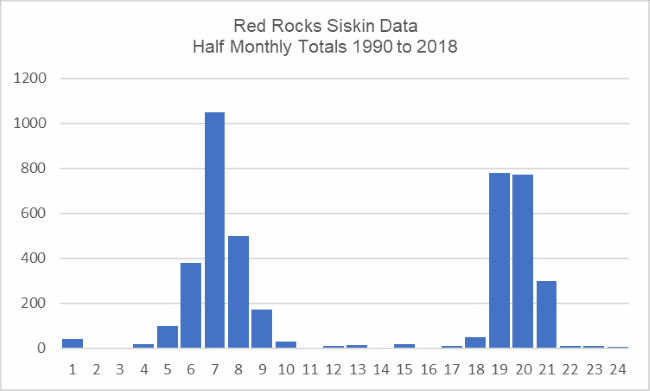
Siskin Status
In these days of declining bird numbers it is
heartening that at least one bird species, Siskin (Spinus spinus), is bucking this
trend. According to the BTO Atlas (2007-11) there was a 166%
increase in it's range since the 1962-72 Atlas and BBS showed a 33%
increase in numbers between 1995 and 2017. This increase has been
fueled by the increase of mature Pine Forests and by birds increasingly
making use of garden feeders in years when the tree seed harvest is
poor.

November 2019 update: Siskins
continued to come through during the
first 10 days of the month with a total of 230 in several flocks,
recorded at Leasowe Lighthouse, Red Rocks and Hilbre (70 at Hilbre on
the 9th was the largest number). Checking back over
the previous four Novembers (i.e. 2015 to 2018) numbers recorded were
far smaller for those years with mostly just a handful of single-figure
flocks, 18 at Leasowe
Lighthouse on Nov 3rd 2015 being the only sizable number; thus
confirming that the autumn of 2019 has been an unusually good year for
species.
Richard Smith
Acknowledgments and References:
1. Red Rocks data provided by Jane Turner for which
many thanks.
2. Eddie Williams and Allan Conlin pers. comm. who
kindly provided data from North Wirral and answered my questions. Many
of the Siskin counts were theirs, along with other birders for which
many thanks.
3. BTO Bird Atlas 2007-11.
4. The Breeding Bird Survey 2018, BTO.
5. David Norman, Birds in Cheshire and wirral (CAWOS
Atlas), 2008.
Colour Ring Report
Apart from knowing that any colour rings you report
are contributing to
the studies into bird migration, longevity etc. it's always fascinating
to get feedback about the movements of any particular bird you have
seen. Sometimes we get much more feedback with details of sightings of
all birds in a particular colour ringing project, such was the case in
November with details of Icelandic ringed Oystercatchers and Sandwich
Terns ringed at
Cemlyn Bay, Anglesey.
Oystercatchers Colour Ringed in Iceland
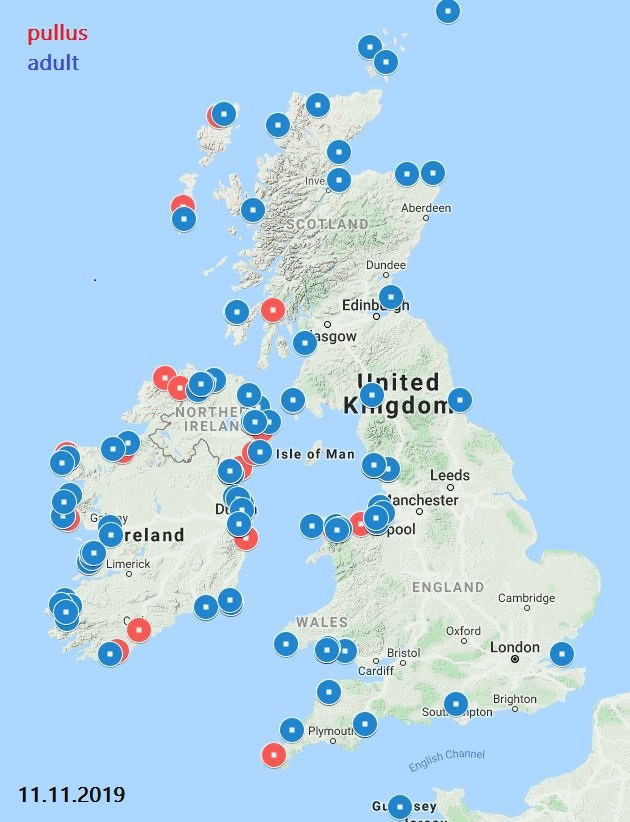
In addition to those shown five have been recorded
in Spain and one in France. The project started in 2013 and about 150
individuals have been recorded giving a wealth of information on
migration routes and strategies.
On the map you can see a cluster of records around the Dee estuary and we have a total of 19 records of seven individual birds, three seen at Hoylake and four at Thurstaston. For further details see "Oystercatchers" in the April 2017 Dee Estuary Newsletter.
Map kindly provided by @icelandwader (Twitter).
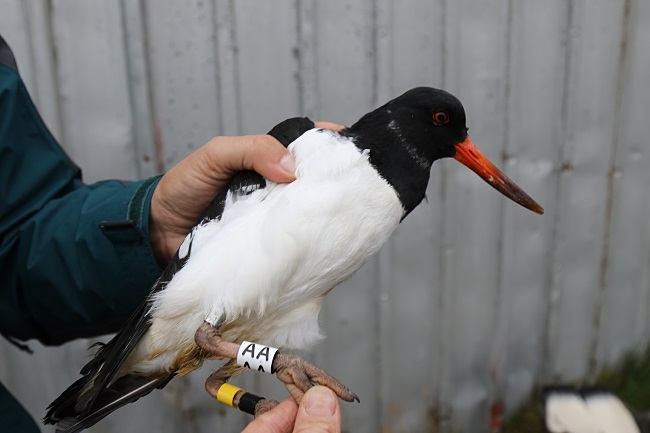
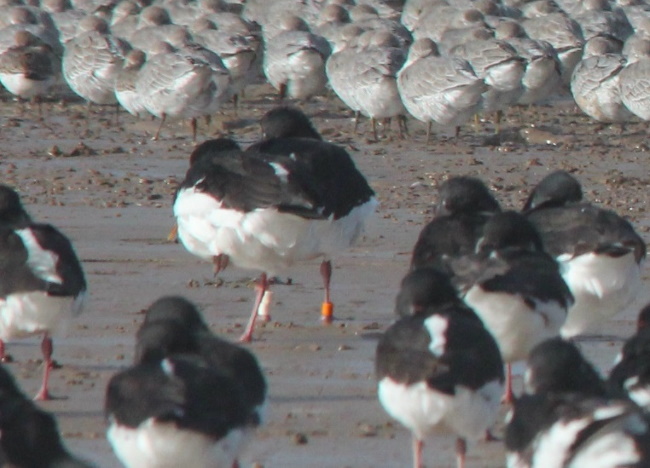
Sandwich Terns
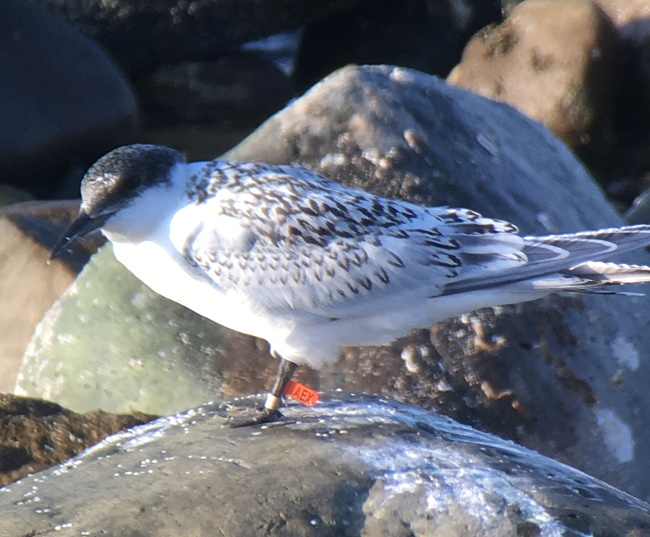
This bird was photographed at Rhos on Sea at 7pm on July 25th
having been recorded that same morning at Hilbre.
On June 18th 2019 123 Sandwich Tern chicks at the
Cemlyn Bay colony were fitted with an orange flag inscribed with three
letters. The Dee estuary and nearby Formby coast is one of the most
important staging posts in the country for this species, holding up to
4,000 birds in July and August, over the years we have
seen colour ringed birds from various Irish Sea colonies, particularly
the Lady's Island Lake colony in County Wexford, and also those on the
east coast of England and Scotland - but none from Cemlyn Bay as none
had been colour ringed
there. So that has now changed and even this first summer and autumn we
have seen some fascinating movements. Already there have been 140
records of 68 birds, 55% of those ringed - a really excellent recovery
rate for a species not always easy to get close enough to read flags.
The map and table below shows where and when the birds were sighted (the numbers show the number of records at each site). The first chick to be seen away from Cemlyn Bay was on July 15th, with the same bird being seen at both Rhyl and Rhos on Sea, several were then recorded on Formby Beach over the next few days. All except one of the Dee estuary records were of birds near Hilbre, but it wasn't easy to get close to them there which is why we only have a total of eight records.
A big surprise was that one turned up just east
of
Edinburgh and it was the same bird which was seen there in July, August
and
September. It just shows how far these juveniles disperse once they
leave the colony. Dublin is actually as close to Cemlyn Bay as Formby
is so it was a surprise that only seven were recorded there, presumably
they prefer to follow the coastline when first leaving the colony
rather than head straight out to sea. September
saw a big drop in numbers and by October one had already reached the
wintering grounds off Gambia, this bird was seen on October 7th, the
same date one was still on the south coast of England at Dawlish Warren.
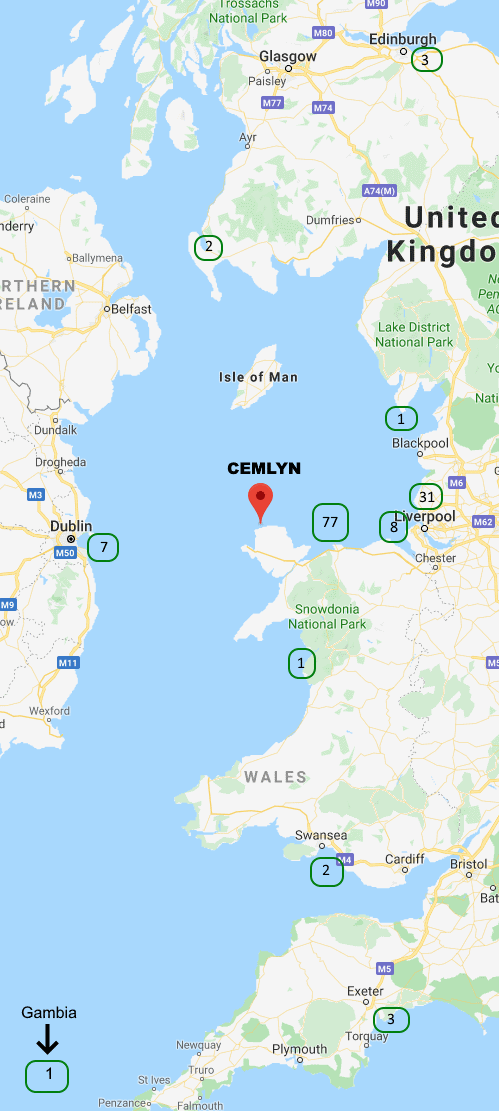
| Site |
Jul |
Aug |
Sep |
Oct |
| North Wales Coast |
20 |
55 |
2 |
|
| Dee Estuary |
7 |
1 |
||
| Formby/Southport |
24 |
4 |
2 |
|
| Walney |
1 |
|||
| Dublin |
3 |
4 |
||
| Cardigan Bay |
1 |
|||
| Stranraer |
2 |
|||
| Edinburgh |
1 |
1 |
1 |
|
| Swansea |
2 |
|||
| Dawlish Warren |
3 |
|||
| Gambia |
1 |
LATEST NEWS:
Just as I was about to publish this newletter news came in of an Orange
flagged Sandwich Tern seen in Namibia (close to Walvis Bay) on
18/11/2019. It was OFlag ACU which was seen at Southport on 24/7/19,
Hilbre on 28/7/19 and Rhos on Sea on 23/8/19.
Many thanks to Steve Dodd for providing the data and
who was one of the ringers, and to North Wales Wildlife Trust who
manage the Cemlyn Nature Reserve which includes the Sandwich Tern
breeding colony.
November Bird News
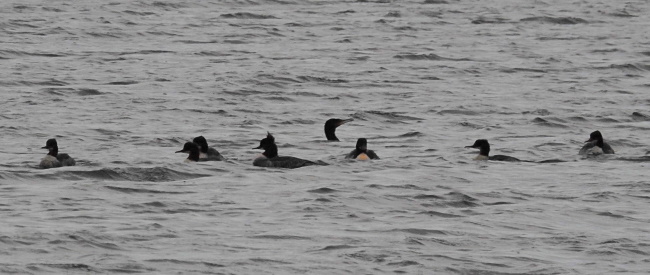
Seven Goosanders on West Kirby Marine Lake on
the 22nd is probably a record high count, they have become regular on
the lake over the past three years but prior to that they were a rarity
with only the odd one briefly touching down there for a day or two.
Numbers in inland Cheshire have increased substantially over the past
10 years so presumably they are part of that expansion.

Two Shorelark were at Gronant early in the month but sadly only stayed a day, and there were several Snow Bunting around including two by Leasowe Lighthouse on the 25th and seven at Point of Ayr two days later.
Two grey male Hen Harriers were recorded and at
least two ringtails through the month. There have been amazing numbers
of Marsh Harriers and around 20 were counted coming to roost at Neston
Reedbed at the end of the month. Also at the reedbed one or two
Bitterns were seen flying into the roost almost every afternoon. There
have been Bearded Tits seen and heard there and also at Burton Mere
Wetlands. 15 was the highest single count of Great Egrets this month.
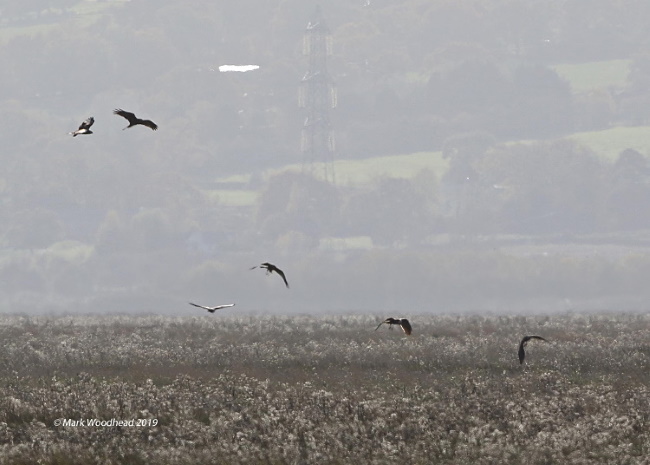
A Slavonian Grebe and Long-tailed Duck were on Shotwick Lake. A Firecrest was a good find at Burton Mere Wetlands and a late Swallow was an unexpected sight at Hoylake on the 25th. A flat calm sea at the end of the month revealed 4,700 Common Scoters off North Wirral.
Winter thrushes have been posing well for some lovely seasonal photos, over 300 Fieldfares were at Deeside Industrial Park.
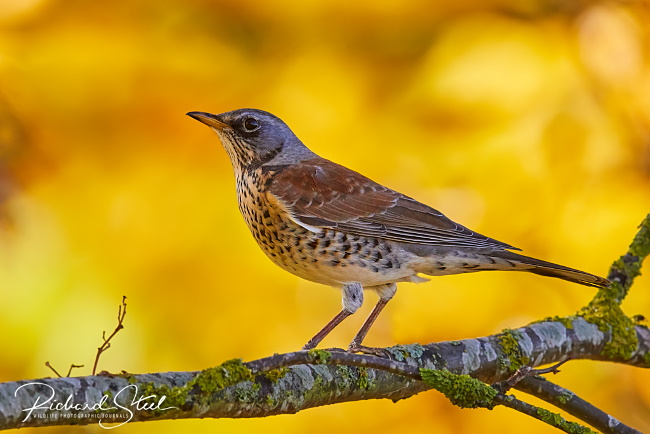
Top of Page
What to expect in December
The marshes will be full of Marsh Harriers, Hen Harriers, Short-eared Owls, Great Egrets and Pink-footed Geese, and look out for the far harder to see Bittern often seen flying into roost at Neston reed-bed.

Forthcoming Events
December Highest Spring Tides (Liverpool)
Also see Tides page.
14th December, 12.13hrs (GMT), 9.3m.
15th December, 12.56hrs (GMT), 9.3m.
26th December, 10.58hrs (GMT), 9.3m.
27th December, 11.39hrs (GMT), 9.4m.
28th December, 12.18hrs (GMT), 9.3m.
Forthcoming Events
Organised by the Wirral Ranger Service , Flintshire Countryside Service and the RSPB (Dee Estuary): All these events and walks have bird interest, even those not advertised specifically for birdwatching. No need to book for these events unless specified - please check below.
Sunday 8th December
and Sunday 12th January
RSPB Raptorwatch at Parkgate.
1pm-dusk
Join us for a chance to see up to seven different birds of prey
including peregrine and merlin, plus two types of owl that all make
their home on the RSPB Dee Estuary nature reserve. With its panoramic
views of the saltmarsh, Parkgate is one of the best places to watch for
the birds hunting. Stick around until dusk for a chance to see the
graceful and endangered hen harriers flying into roost for the night on
the marsh close to the Old Baths car park, plus a ghostly barn owl
emerging to hunt. No booking required, come along any time between 1pm
and sunset. Dress appropriately for the weather and don't forget your
binoculars! Public toilets and various pubs and cafes are situated
close by along Parkgate promenade.
Telephone 0151 353 2720 for further information.